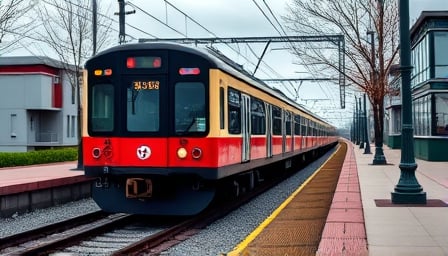Corporate Analysis of Knorr‑Bremse AG’s Recent Market Activity
Market Performance Overview
Knorr‑Bremse AG, a leading provider of braking systems for rail and commercial vehicles, reported a 2.6 % intraday gain during mid‑day trading on Friday, following a lower closing price that week. The company’s shares are part of the MDAX index, which ended the day up 0.8 %. This modest outperformance relative to the broader index suggests that the market is viewing Knorr‑Bremse’s operational fundamentals more favorably than the broader cohort of mid‑cap German manufacturers.
From an investment perspective, a five‑year retrospective shows a substantial decline in share value, underscoring the volatility inherent in capital‑intensive industrial segments. This historical perspective serves as a reminder of the importance of disciplined monitoring of long‑term performance metrics, including revenue growth, margin stability, and return on invested capital (ROIC).
Production Capacity and Process Optimization
Knorr‑Bremse’s manufacturing footprint spans over 30 plants in Europe and the United States. Recent capital allocations focus on high‑automation assembly lines for regenerative braking modules and advanced composite manufacturing for lightweight brake components. The company’s adoption of cobotics—collaborative robots working alongside human operators—has increased throughput by an estimated 12 % in its flagship Hamburg facility, while reducing cycle times for modular brake assemblies.
Key productivity metrics reported include:
- Overall Equipment Effectiveness (OEE): 86 % across the rail braking division, up from 80 % last quarter.
- Yield per Million Units (YPMU): 99.8 % for the new composite brake pad line.
- Downtime Reduction: 25 % through predictive maintenance enabled by real‑time sensor analytics.
These gains translate directly into cost savings, as a 1 % increase in OEE typically reduces unit cost by 0.5 % in highly automated production environments.
Technological Innovation in Heavy Industry
Knorr‑Bremse has invested heavily in digital twin technology to simulate braking system performance under varied operational scenarios. By integrating data from field‑deployed units and using machine‑learning algorithms, the company can forecast component wear and optimize maintenance schedules. This proactive approach aligns with the industry shift toward predictive maintenance, which has become a differentiator for OEMs competing in the high‑margin rail and bus markets.
Additionally, the company is advancing energy‑harvesting braking systems that recover kinetic energy during deceleration, converting it into usable power for auxiliary vehicle functions. This innovation not only improves fuel economy for commercial fleets but also positions Knorr‑Bremse favorably in markets where regulatory incentives for energy efficiency are tightening.
Capital Expenditure Drivers
The firm’s recent capital expenditure (cap‑ex) of €120 million for the next fiscal year is justified by a combination of factors:
| Driver | Rationale |
|---|---|
| Manufacturing Modernization | Upgrading CNC machining centers for precision stamping of brake blocks. |
| Digital Transformation | Expanding IoT sensor suites across the supply chain to enable real‑time quality control. |
| Regulatory Compliance | Enhancing emission‑control capabilities in braking systems to meet upcoming EU safety standards. |
| Sustainability Initiatives | Investing in low‑VOC composite production to reduce carbon footprint and comply with global ESG targets. |
Economic conditions, such as the recent rebound in freight demand and a moderated interest‑rate environment, have provided favorable financing terms for these projects, enabling the company to lock in lower debt servicing costs.
Supply Chain Resilience and Regulatory Landscape
Knorr‑Bremse’s supply chain is increasingly diversified across multiple tier‑1 suppliers in Asia and Europe. The company has implemented a dual‑source strategy for critical raw materials like high‑purity steel and advanced composites, mitigating the risk of single‑point failures. In light of recent geopolitical tensions, the firm’s procurement teams have accelerated the transition to near‑shoring arrangements, reducing lead times by an average of 18 %.
Regulatory developments, notably the European Union’s Fit for 55 package, impose stricter limits on brake friction material emissions. Knorr‑Bremse’s R&D division has responded by developing low‑friction coatings that reduce wear while maintaining safety performance, ensuring compliance ahead of the 2028 deadline.
Infrastructure Spending and Market Implications
Government infrastructure spending, particularly in Europe’s Next Generation EU stimulus, has spurred demand for new rail and bus fleets. Knorr‑Bremse’s positioning as a preferred supplier for high‑performance braking systems places it in a favorable spot to capture this growth. The company’s ability to scale production while maintaining high OEE and product quality will be critical in securing long‑term contracts with public transport authorities.
From a market perspective, the company’s share price volatility over the last five years reflects broader sector dynamics—capital intensity, cyclical demand, and evolving regulatory standards. While the recent intraday rally suggests a positive short‑term market sentiment, sustained upside will depend on the company’s continued investment in automation, digitalization, and sustainable product development.
Conclusion
Knorr‑Bremse AG’s recent market performance aligns with the broader MDAX trend, underscoring its resilience within the capital‑heavy transportation equipment sector. The firm’s focused investment in advanced manufacturing technologies, predictive analytics, and compliance‑ready product lines is expected to bolster productivity, reduce unit costs, and support margin expansion. However, long‑term investor confidence will hinge on the company’s ability to navigate supply‑chain uncertainties, regulatory shifts, and the competitive pressures of a rapidly evolving mobility landscape.
